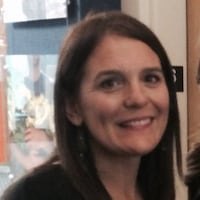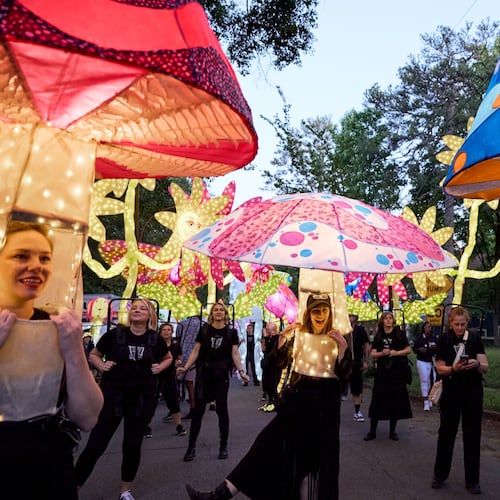Day after day, Mary Maurer practices mundane, everyday tasks such as folding laundry, getting dressed, even standing for five or 10 minutes at a time.
A patient at WellStar Cobb Hospital for the past three weeks, the 80-year-old Maurer, who suffered a hip fracture in late April, is undergoing occupational therapy designed to get her ready to return home.
It’s tedious, of course. And as much as the hospital’s rehab unit tries to offer a home-like setting, complete with washers and dryers, stoves and sinks, it falls short in one key area. Hospitals, by their very nature, are confined by four walls.
But at WellStar Cobb Hospital in Austell, there’s a different kind of therapy taking patients outside, time and time again, to garden. For Maurer, that means feeling closer to her real-life, everyday routine at home.
Clad in sneakers and a blue visor, Maurer smiles and takes in a deep breath the moment she exits the hospital and feels the cool breeze tickle her red curls.
“Looking at four walls all day, this is a welcome change,” says Maurer, still in a wheelchair, but hoping to walk again soon.
Like many patients at WellStar Cobb Hospital’s rehabilitation unit, Maurer eagerly opted to replace one of her three to four hours of therapy on Wednesdays with an hour of outside gardening.
For the next hour, Maurer “lifts weights” and works on “standing endurance.” In other words, she tends to the garden. Lifting a hose to water plants and flexing muscles to pull carrots from the soil doesn’t feel like therapy. It just feels like gardening.
A welcome diversion
On a recent afternoon, Maurer warms up to the weekly garden therapy by rubbing rosemary and lemon grass between her fingers.
In a hospital gym, the clock can move slowly, the exercises boring, the air stale.
But here, Maurer can lose track of time. But while garden time may seem like play-in-the-dirt time, occupational therapists see it as a creative way for patients to rebuild weak muscles and ultimately regain independence.
Maurer’s occupational therapist, Brittnee Howell, said the garden provides a welcome diversion for patients in the rehab unit (where patients stay on average about two weeks). At the same time, giving patients shovels and letting them pluck flowers, plant seeds, pick blueberries reminds them what awaits them once they’re out of the hospital.
For a wistful Maurer, smelling the rosemary reminds her of the soups and stews she likes to season with this favorite herb. It reminds her of her patio at her Austell house, where she and her husband, Frank, have lived for 33 years. The patio holds a picnic table, a place to sit and enjoy warm days, a place to grill when company visits.
It’s also a place where she has dabbled in gardening. She’s planted tomatoes to mixed results. She has had better luck with rosemary.
In late April, Maurer fell at home shortly before dinner. Rushed to the hospital in an ambulance, she underwent surgery and has been recovering ever since.
Patients perk up
WellStar Cobb’s garden goes back many years, first taking root in 1992 under the guidance of Becky Blades, a Cobb County volunteer master gardener. Since then, the cheerful gardener with a big smile has been here every week, most months of the year.
Blades said the key modification of the garden was raising the beds off the ground to make plantings easier to reach. Otherwise, the patients use regular tools and hoses. Some of these gardeners have suffered strokes. Others have fallen and broken bones. Some have suffered an illness and simply need time to rebuild their strength from being bedridden. Virtually everyone benefits from the garden therapy.
“Some patients understandably can be down being at the hospital, and they come here and you can see them perk up,” said Blades as she shared a bag of fresh peas with patients and staff. “In all these years, I think we’ve only had two grumpy people who didn’t perk up being out here.”
Other area medical centers also use gardening as a form of healing. Piedmont Hospital and the neighboring Shepherd Center both weave garden therapy into their programs. Both help teach patients how they can use adaptive equipment to either continue gardening or take up it as a new hobby.
Tea and good fortune
Back in Austell, Maurer tends to the WellStar garden, examining the potato plants with bright purple leaves. Her occupational therapist times just how long Maurer is up on her feet. One, two, three minutes. Maurer doesn’t request a break until she has been up for seven minutes.
She places some carrots she’s picked into a plastic bag and returns to the rehab unit. But the garden therapy doesn’t stop there. Later in the day, she and other patients wash the carrots, peel them, and boil them for a tasty, garden-fresh side dish for dinner.
Her occupational therapist also has an idea for Maurer’s mint leaves.
While Maurer goes off to speech therapy, the therapist brews a cup of tea and drops the fresh mint on top. The tea is waiting for her when she gets back.
She can’t see it in the tea leaves, but there is more good news awaiting her: Tomorrow, her doctors tell her, she’ll be going home to her own patio and garden.
About the Author
Keep Reading
The Latest
Featured


